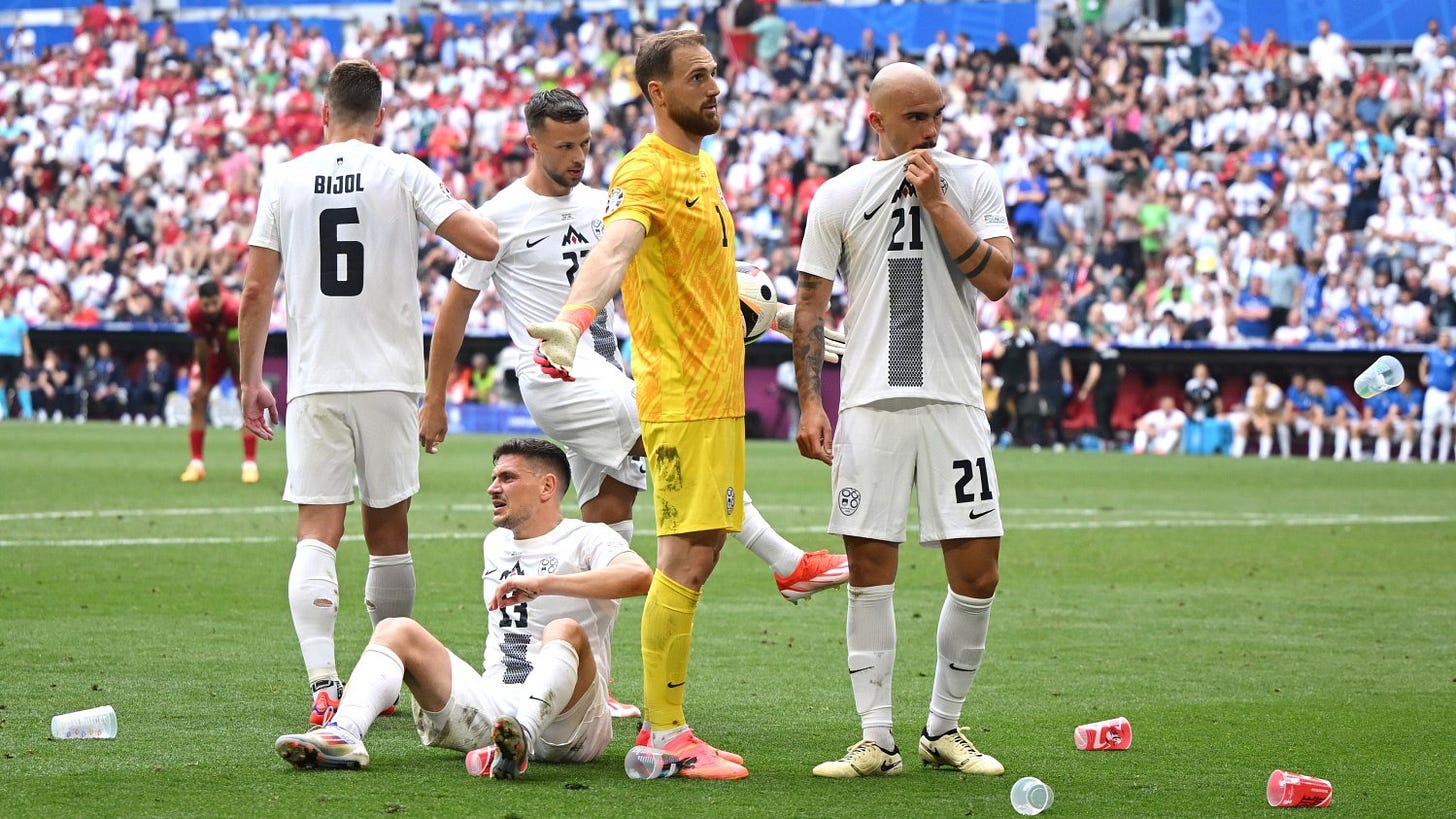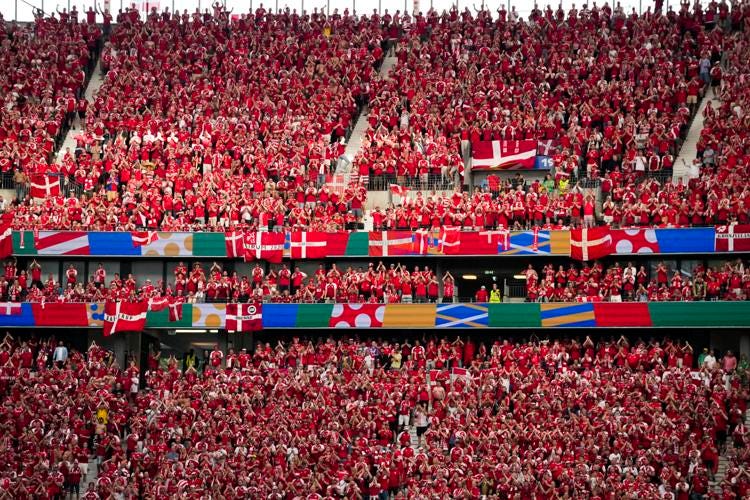A complicated set of tiebreakers (Euros 2024 edition)
Denmark and Slovenia tried to take it to the limit, but didn't need to go that far
The group stage of the Euro 2024 football tournament, contested in Germany this year, has had some thrilling matches with a lot of late goals. Tuesday, there were four matches, only one of which was interesting (Austria’s 3-2 win over Netherlands) and the final two matches of the day, England-Slovenia and Denmark-Serbia were stultifying scoreless draws.
But, the scorless draws in the late matches made people try to figure out just who would finish second in Group C (and qualify for the next round automatically) and who would finish third (and also end up qualifying, but that wasn’t guaranteed until everything played out.)
Group C consisted of England, Denmark, Slovenia, and Serbia. Of the six matches in the group, all but one ended in a draw. That was England’s 1-0 win over Serbia in their opening match. Denmark and Slovenia tied their other two matches. Serbia drew its other two as did England. 1
So this left the group with standings of:
England 1W 2D 0L 2 GF 1 GA 4 pts
Denmark 0W 3D 0L 2 GF 2 GA 3 pts
Slovenia 0W 3D 0L 2 GF 2 GA 3pts
Serbia 0W 2D 1L. 1 GF 2 GA. 2 pts2
England, despite playing a brand of football that has left one big section of the United Kingdom in total despair, won the group. Denmark and Slovenia tied for second with 3 points. Serbia in fourth place was eliminated.
The Euros have 24 teams and 16 move on to knockout play3. There are six groups of four teams, so the top two in each group, plus the four best third place teams advance. Because of how other groups were shaking out, the third place team in Group C was guaranteed to advance, but who was the third place team: Denmark or Slovenia.
Fortunately, UEFA, who organizes the tournament, has the fabled Complicated Set of Tiebreakers.
The first tiebreaker is head to head record in matches between tied teams. Denmark and Slovenia played a 1-1 tie. So that’s a wash.
The second tiebrakers is goal difference in matches between tied teams. Again since the teams in question drew, that’s level. This step exists to break most 3-way or 4-way ties.
The third tiebreaker is goals scored in matches between tied teams. Again, that’s the same.
The fourth step deals with what to do if a 3-team or 4-team tie has been reduced by at least one team. But since this is a 2-team tie, we press on!
The fifth step is goal difference in all group matches. Both teams had a goal difference of zero. We need another step!
The sixth step is goals scored in all group matches. Denmark scored two and Slovenia scored two.
This leads to the fateful seventh step: disciplinary record. Teams that accrued fewer disciplinary points during the group matches would prevail. Teams pick up one point for each yellow card and three points for either a staight red or a second yellow leading to a red. When the game was over, most people thought that the teams were tied in this category with six yellow cards apiece. But, for reasons unknown to many, UEFA’s boxscores didn’t list that a Slovenian assistant coach got a yellow card during the match against Denmark. This counted in this category. And finally the tie was broken. Denmark was second and Slovenia was third.
If that Slovenian coach had avoided the yellow card, Denmark would still have won on the eighth tiebreaker, which was better record during qualifying. Denmark and Slovenia were in the same qualifying group and they both finished with 22 points. Although for tiebreaking purposes, both teams matches against sixth placed San Marino would have been tossed out. This would have left both teams with 16 points. during qualifying, the teams tied in Slovenia, but Denmark beat Slovenia 2-1 at home and that gave them the edge in that.4
The two final groups are being decided on Wednesday, Groups E and F. Group E has four teams all tied with three points as the teams as all the teams have one win and one loss. There could be a four-way tie if both matches (Belgium vs Ukraine and Romania vs Slovakia) end up draws. And this would see a team with four points being eliminated while three teams with just three points could be advancing.
Despite the four way logjam, the tiebreaking wouldn’t be as complicated because the teams all have different numbers of goals for and against. Romania owns the most tiebreaker edges thanks to having the biggest win in the group, a 3-0 win over Ukraine. Romania needs only a draw to advance. The same is true for Belgium and Slovakia. Ukraine must win its final game to advance, or, get a draw and hope that the Romania-Slovakia match does NOT finish in a draw.
Looking at it another way, if all four teams end up with four points, Ukraine is the odd team out. Ukraine could advance with a loss to Belgium as long as it wasn’t by more than one goal and the team doesn’t pick up NINE yellow cards or mulitple red cards (or some combination).

Group F already has a winner in Portugal, but none of the other three teams have clinched a spot. Turkey (UEFA is using the country’s new preferred spelling of Türkiye) is in second place with 3 points with Czechia (the Czechs prefer this name to Czech Republic) and Georgia tied with 1 point.
The Turks will get second place with a draw against the Czechs. The Czechs will advance with a win and be eliminated with a draw. Georgia will advance with a win over Portugal and be eliminated with any other outcome.
Two of the four third place qualifiers are set in Netherlands and Slovenia. One team from Group E will very likely qualify as a third place team. That leaves Hungary hoping that both the Czechs and Georgians lose to let them advance.
Over in this hemisphere, Copa America is being played in the United States in much less frantic atmospheres and smaller, more subdued crowds. It has a slightly less complicated set of tiebreakers. As a 16 team tournament, there are just four four-team groups and only the top two advance.
The tiebreakers for this tournament are: goal difference, goals scored in all group matches and if there are still ties, then head to head record comes into play. If that’s still a tie. The next tiebreaker is fewer red cards. Then fewer yellow cards. And then it’s time for a random draw.
You probably could have figured out who had how many draws after I said there was only one win.
I would learn how to make a table, but I am lazy.
The 2026 World Cup will feature 48 teams and there will be 12 groups with the top two in each group advancing, plus the eight best third place teams moving on to a round of 32. After a while, you will be wondering just how many matches you have watched. The answer will be: a lot.
If Germany, who as host nation, didn’t have to play qualifiers, had been in this qualifying step, they would have just drawn lots.




